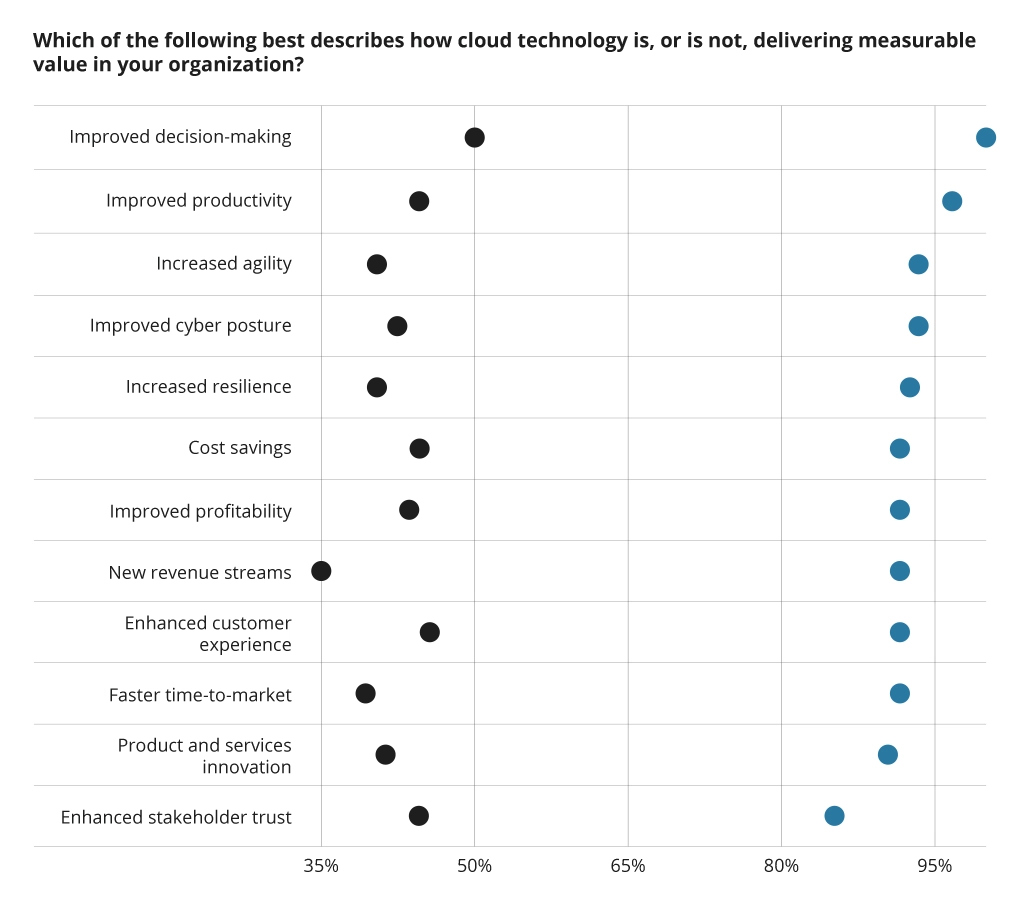6 Scenarios When Full Cloudification Won't Work
With the advent of cloud computing, the shift can be compared to the emergence of public transportation. Cloud services offer a shared, efficient, and cost-effective mode of "public transport" for businesses. Instead of owning and maintaining individual vehicles (servers and hardware), businesses can now leverage the cloud as a service, much like hopping onto a public bus or train—reducing the burden of infrastructure management and providing a more flexible, scalable, and collaborative way to navigate the digital landscape.
While numerous businesses are using cloud technologies, cloudification cannot be a cure for all problems. It’s like expecting one tool to fix every issue in a complex machine. The transition of companies to cloud-based business support has, in fact, introduced new challenges that need to be addressed.
In this article, we talk about six scenarios where total cloudification might not be viable and explore alternative solutions.
Why Go Cloud in the First Place?
First things first, let’s clarify why organizations consider restructuring their business models using cloud technology.
While relatively recent, digital transformation seems to represent the next evolutionary phase in the economy, and its impact is evident. Among traditional small businesses, 44% utilize cloud infrastructure or hosting, contrasting with 66% of tech-based small businesses and 74% of enterprise companies. Not to mention 100% of cloud-powered companies that have refined decision making through cloud innovation.
On the graph below, you can notice a significant gap between cloud-powered companies (depicted by blue dots) and other companies (black dots) in terms of the value derived from the cloud transformation.
What attracts companies of all types and sizes to the cloud? Its clear-cut and tangible benefits:
- Increased Agility: The heightened flexibility resulting from cloud migration enhances overall operational responsiveness and competitiveness. For instance, an agro giant demonstrated increased agility by replacing a legacy data management system with a cloud data warehouse solution on Microsoft Azure.
- Cost Savings: Cloud technology minimizes operational expenses through efficient resource utilization and the elimination of legacy infrastructure burdens — just as demonstrated by our custom cloud solution, which emulates Google Cloud functionalities and played a pivotal role in helping our client eliminate a significant €100 million annual expense tied to legacy VMware infrastructure.
- Improved Cyber Posture: The cloud environment offers advanced security measures and centralized monitoring, ensuring heightened protection against evolving cyber threats. When the energy corporation DTEK aimed to fortify their IT service authentication amidst the rise in remote work, we went beyond, laying the groundwork for a robust foundation in advanced IT security.
- Improved Resilience: Cloud architecture enhances organizational resilience, guaranteeing uninterrupted operations and swift recovery from potential disruptions. Read the tech story detailing Infopulse experience in implementing a Disaster Recovery Plan (DRP) and executing a migration strategy. This involved transitioning critical infrastructure to a remote data center in Kyiv amidst a crisis in 2022.
The cloud promises unparalleled efficiency and innovation. However, practical challenges emerge in certain business scenarios, making an all-cloud approach impractical. Let’s investigate them.
Six Business Cases When Going All-Cloud Isn’t an Option
1. Legacy Systems and Applications
Monolithic structures, not initially designed for the cloud, face compatibility issues when thrust into the cloud "as is." Picture a financial institution relying on a decades-old transaction processing system, struggling to adapt its legacy infrastructure to the dynamic nature of the cloud.
However, there are hybrid-cloud solutions that provide a practical option for organizations seeking to harness the agility and security advantages of the cloud without committing to a full migration. Services acting as bridges between on-premises and cloud environments enable this integration seamlessly.
Solutions: One such notable solution is Microsoft Azure Arc, a service that extends Azure's management and security capabilities to on-premises environments. It presents a centralized approach to overcoming the limitations of legacy systems. Legacy systems can leverage Azure Arc without a full transition to the cloud in several ways:
- Centralized Management: Azure Arc allows organizations to centrally manage on-premises servers, Kubernetes clusters, and applications, by collecting event logs in the cloud and enhancing efficiency and streamlining operations.
- CI/CD (Continuous Integration/Continuous Delivery) for On-Premises Kubernetes: Clients with local Kubernetes benefit from Azure Arc's support for modern CI/CD practices. The integration allows for the efficient management of configurations and facilitates updates for on-premises Kubernetes clusters, ensuring a smooth and automated deployment pipeline.
- Security and Governance: Azure Arc extends Azure's security features to on-premises environments. This includes tools such as Azure Sentinel for advanced threat detection and security information and event management (SIEM). Legacy systems can thus enhance their security posture without undergoing a full cloud migration.
2. Regulatory Compliance and Data Governance
In sectors like healthcare and finance, adherence to stringent regulatory frameworks for handling and storing sensitive data is non-negotiable. Naturally, the challenge arises when these industries face limitations in migrating certain services or databases to the cloud due to regulatory constraints.
A strategic solution emerges as companies address this obstacle by establishing localized data centers, aligning with the geographic requirements mandated by regulations. A notable example is Microsoft's approach in Switzerland, where the company tackled this issue by constructing dedicated data centers, ensuring that sensitive data remains within the country's borders.
What are other ways for organizations to harness the advanced security measures and cutting-edge technologies offered by the cloud while retaining their infrastructure and data on-premises? Cloud security solutions provide flexibility and scalability, empowering enterprises to maintain control over crucial aspects of their IT environment.
Solutions:
- Vulnerability Assessment: Implementing thorough vulnerability assessments is pivotal for organizations to proactively address security risks. Not only does this approach cultivate a culture of continuous evaluation, but also ensures compliance with regulatory standards.
- Event Log Monitoring and Management with SIEM: SIEM solutions are instrumental in monitoring and managing event logs within an organization's network. These solutions categorize diverse logs, including logins and logoffs that enable continuous monitoring and facilitate the timely detection and response to security incidents.
- Microsoft Purview enables the connection to databases for scanning and categorizing data. Azure Purview supports over 100 built-in classifications, spanning credit cards to government IDs and location data. This approach enhances data protection and aligns with regulatory standards governing sensitive data handling and categorization.
3. Security Concerns
Industries dealing with highly sensitive information, like defense or government agencies, encounter obvious “classified data” challenges when considering migration to the cloud. How can these organizations enhance the security of their sensitive data? One of the ways is to leverage advanced cloud security technologies while upholding data privacy and compliance.
Solution: An effective solution involves the implementation of controlled access points, enabling cloud services to connect with on-premises systems. This hybrid approach provides a middle ground, allowing organizations to benefit from the cloud technology while maintaining a strong security framework for sensitive information. You can consider the options of hybrid cloud or zero trust architectures.
4. Cost Considerations
Transitioning to the cloud poses a significant financial challenge, with 55% of organizations citing cost management as their primary concern (IDC). The perceived high cost includes factors such as infrastructure provisioning, data transfer, storage, and ongoing operational expenses. What strategies can be employed to address these concerns? Is it feasible to achieve cost savings without committing to a full-scale migration?
Solution: In contrast to a comprehensive migration, Azure Arc provides organizations with the ability to optimize their existing infrastructure. This approach minimizes immediate costs and facilitates a gradual cloud transition.
5. Resource-Intensive Workloads
Many resource-intensive workloads, like scientific simulations and rendering, face challenges in the cloud due to mismatched hardware requirements and generic cloud infrastructure. But what if your organization requires the unparalleled scaling capabilities that the cloud offers?
Solution: Integrating resource-intensive workloads with DevOps CI/CD processes and managing them through Kubernetes is a viable solution. This approach enables efficient scaling and granular control, ensuring the ability to meet varying workload demands effectively.
6. Resistance to Change
Even though 60% of workers will require training and reskilling by 2027, employees and stakeholders may still be hesitant or apprehensive about adopting new technologies and processes. However, what if you still aim at the enhanced agility, resilience, and cybersecurity benefits while simultaneously reducing costs?
Solution: Once again, Azure Arc steps in. The solution's versatility lies in its connecting capability, serving as a bridge between the current on-premises infrastructure and the cloud. With a phased approach, teams can gradually acquaint themselves with cloud functionalities without disrupting established workflows, effectively minimizing resistance through a comfortable transition period.
Final Word
At Infopulse, we recognize that while cloud solutions often offer tremendous benefits, they may not be the optimal fit for every situation. We are dedicated to finding alternative, tailor-made solutions that align with the unique needs and circumstances of our clients.
As a Microsoft, AWS, SAP, and Oracle partner, we possess the expertise to match your business with a personalized service.







![FinOps: Key Principles and Benefits [thumbnail]](/uploads/media/thumbnail-280x222-cloud-cost-optimization-with-finops.webp)
![Azure Arc [thumbnail]](/uploads/media/thumbnail-280x222-azure-arc-multi-cloud-management.webp)
![Security Guide for Cloud Migration [thumbnail]](/uploads/media/thumbnail-280x222-security-when-migrating-apps-to-the-cloud.webp)
![AWS migration strategy [thumbnail]](/uploads/media/thumbnail-280x222-aws-migration-strategy.webp)




